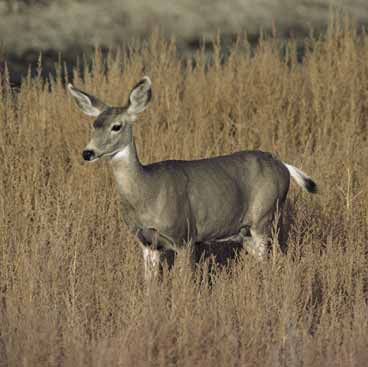 |
| Black-tailed deer |
The Nature of Cedar Mill
Dear, There’s
a Deer Here!
Kyle Spinks
Natural Resources Technician, THPRD
Here in this arm of the Coast Range known as the Tualatin Mountains
(the West Hills to most of us) you are likely to see deer moving
across the road, roaming across the meadows, or munching on vegetables in
our yards. The white-tailed deer can be recognized by its tail— tan
with an all-white underside that it flashes upward when alarmed.
The black-tailed deer (a subspecies of mule deer) is found west of the Cascade
Range and has a tail that is all or mostly black on top. This deer also
has a distinctive white rump patch that the white-tailed deer is lacking.
They are similar in size, with bucks averaging about 150 pounds and does
averaging 100-125 pounds. Both are seen around here.
The bucks of both species grow antlers which are shed each winter,
usually by March, and grow back each year, typically larger each
time. These are not true horns, since they aren’t actual outgrowths
of the bones of the skull, but are horny structures supported on a pad on
the head. The antlers of our two species are distinctly different. The black-tailed
deer antlers are fairly evenly forked, with pairs of forks that are upward
sweeping. The white-tailed deer antlers have smaller tines that branch off
the main tine, rather than paired forks, which are more forward pointing
than those of the black-tailed deer.
Early-season antlers are soft and well supplied with blood by a thin
layer of skin covered with fine hairs, called velvet. As the season
progresses, the antlers harden and the velvet dries and begins
sloughing off. A common myth is that the sloughing velvet is itchy, so the
bucks rub their antlers on vegetation to remove the old skin.
The real reason for rubbing trees and shrubs is to mark territory. Bucks
will scrape the bark and leaves off the woody vegetation then
rub their two facial glands on the trees to identify themselves to other
bucks, and to receptive breeding does.
Most of us are delighted to see deer in the area, but sometimes they
can cause problems. As with dealing with other urban wildlife
that may become problematic in our yards, there are specific things we
can do to make their visits less bothersome. Here are a few tips
to limit any problems that arise when these deer decide to visit:
- Use landscaping plants that deer don’t find tasty. Lists are
available in such books as Landscaping for Wildlife in the Pacific Northwest
(available at our library) and Deer Proofing Your Yard & Garden.
- Make sure you pick up the fruit from your trees and shrubs. An added
benefit is that this gleaning will reduce the wasps that also
like the fallen fruit!
- Landscape your yard to make it uninviting. Deer will often use an entry
location repeatedly, so planting deer-repellant plants at that
location will discourage their entry. Also, taller shrubbery is harder for
deer to move or see through. Planting hedgerows of taller shrubbery will
deter entry into those areas.
- If you have a fence, make the ‘landing area’ on your side
of the fence hard to hit. That is, increase the width of your garden beds
so that deer that leap your fence won’t be able to land as safely…or
at all!
|
